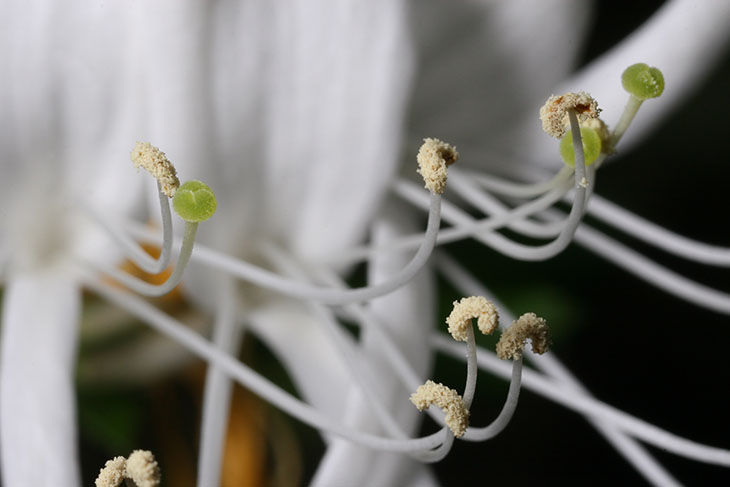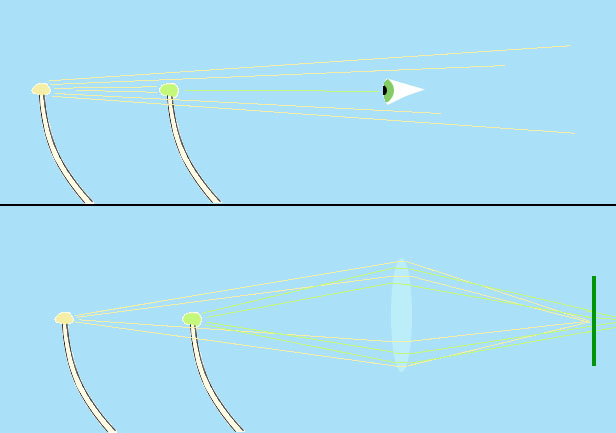
The other day I went out chasing pics again, and didn’t really snag much of merit. But while playing around with macro shots of honeysuckle flowers, I captured a few frames that illustrate a peculiar, and sometimes handy, photographic trait. It takes some explaining, so bear with me.
First, the illustration. These are two frames from almost exactly the same vantage point, with just a change of focus in between. The green stigma is in front of the yellow anthers bearing the pollen in both images. But as can be seen, it is rendered almost invisible in the right side, plainly semi-transparent.

How can this occur?
The first thing to remember is, when we look at something with our naked, or even demurely clad, eyes, we’re seeing through the tiny hole of our pupil. Photons that reflect from any surface all have to pass through this opening for us to see anything, and the size of the opening restricts both how many photons can come through, and from what angle. Objects reflect light not just towards us, but in all directions; most of it we simply do not see. And in the case of the stigma and anther, as illustrated in the top part of the image below, the stigma is sufficient to block most of our view of the anther.

But a camera lens, and indeed many other lenses such as telescopes and binoculars, are different. They’re much larger than our pupils, so they capture a much greater percentage of the light reflecting from an object, everything that hits their front surface – properly focused, they take all of these photons, every path that meets the lens, and converge them back into a sharp image. The larger the lens surface (which usually means the ‘faster,’ or the greater the aperture,) the more light is gathered. This is why a 300mm f2.8 lens is so much larger than a 300mm f5.6.
This means that the green stigma may not necessarily block the view of the yellow anther, because the lens can also see past the stigma, to either side, above and below. While a portion of the view is blocked, not all of it is, so some of the light from the anther comes past. This gets focused down onto the film/sensor plane (shown in deep green.)
Yet, what about the green stigma? It’s still there, and still sending its own reflected light to the lens, right? True enough, but it’s out of focus, so the light paths do not converge back down into a sharp image; instead, the light is somewhat scattered, diffused over a greater area, while the light from the yellow anther is concentrated tightly (this pretty much defines the difference between unfocused and focused.) Light from the green stigma hits the film/sensor in the same place as light from the yellow anther, but the anther’s light is more concentrated, and overpowers the stigma’s. It’s not exactly transparency, it’s just that the object with the most light takes precedent.
This method works best when there is a large difference in focus (which usually translates as distance) between two subjects, and can be used to blur out a fence that blocks our view, for example. The higher the depth of field, of course, the weaker the effect, because the light from the green stigma would become more focused and concentrated. Since lenses are usually at maximum aperture while we’re framing our subject, only closing down to the desired shooting aperture after we trip the shutter, this can sometimes play against the macro photographer: when chasing subjects down among the plants, a leaf or stem can actually be directly between the camera and the chosen subject, but so far out of focus that it is virtually transparent to us through the viewfinder – only to burst into sharper focus and obliterate the subject when the shutter is tripped and the aperture closes down, re-concentrating the light from the leaf/stem. If the object is bright enough, even well out of focus it can throw a color cast across the subject, exactly as seen above.
Our eyes have lenses too, and the effect is exactly the same, but since they’re much smaller it is not as pronounced, and we tend to ignore it when it occurs. However, you can close one eye and hold something narrow like a toothpick vertically in your vision path while focused on something well past the toothpick, and see the same effect, just probably not to as high a transparency as the photo shows. Also, since we have two eyes, the other one may have a clearer view, and our brains can select which eye to give its attention to, so issues only arise on those rare occasions when either eye has a radically different view from the other, such as when we try to see into a narrow gap (especially when we want the depth-perception that two eyes provide.)
I have a page dedicated to explaining how and why aperture affects focus, if you want further information – just click here. It also explains some of the weird things that might occur, and why there is a limit to closing down aperture to increase depth of field.




















































